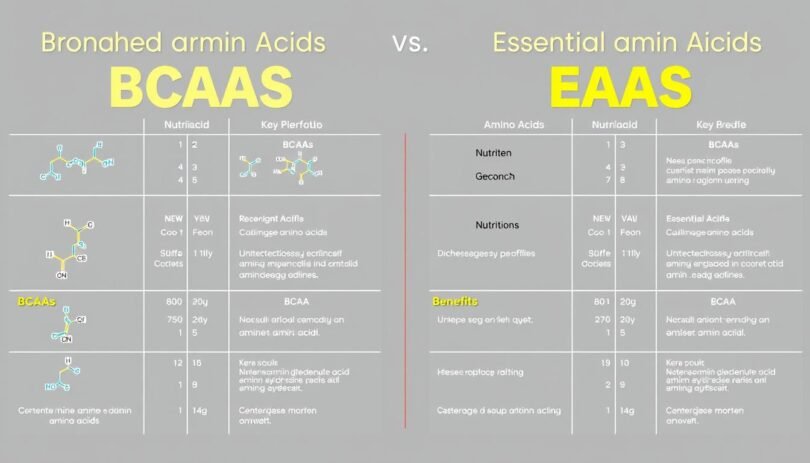If you’re into fitness, you’ve probably thought about BCAAs and EAAs. It’s natural to wonder what sets them apart. Amino acids play a big role in how your muscles grow and recover. They even affect how you feel during exercise.
This article aims to clear up any confusion. We’ll look at the facts so you can make informed choices about your supplements.
Key Takeaways
- BCAAs (leucine, isoleucine, valine) are a subset of the 9 EAAs your body can’t make.
- EAAs support muscle repair, hormone production, and energy, while BCAAs target workout performance.
- Combining both may boost results more than using one alone, per studies.
- Nutrabay Gold BCAA 4:1:1 and 8:1:1 formulas highlight leucine’s role in growth.
- Vegetarians may need EAA supplements to fill dietary gaps in complete proteins like quinoa or soy.
What Are BCAAs?
Branched-chain amino acids (BCAAs) are three key amino acids: leucine, isoleucine, and valine. They are vital for building muscle. Their unique structure lets them go straight to muscles during exercise.
Definition of BCAAs
BCAAs are part of the nine essential amino acids our bodies need. We can’t make them, so we must eat them. Leucine boosts muscle growth, isoleucine helps with energy, and valine increases endurance. They make up about 35% of muscle protein.
Common Sources of BCAAs
- Food sources: Chicken, eggs, whey protein, and soy are rich in BCAAs.
- Supplements: Nutrabay offers BCAA blends in different ratios, like 2:1:1 or 4:1:1.
Benefits of BCAAs
BCAAs help reduce fatigue and prevent muscle damage during exercise. Leucine is especially good for muscle repair after workouts. They might also reduce soreness after hard training. But, too much can upset your stomach, so stick to the right amounts.
“BCAAs’ direct muscle metabolism makes them a go-to for athletes seeking rapid energy and recovery,” says a 2020 review in the Journal of the International Society of Sports Nutrition.
Knowing how BCAAs work with EAAs helps us see their importance in fitness. BCAAs help right after exercise, while EAAs support overall health. Using both wisely can help you reach your fitness goals without losing nutritional balance.
What Are EAAs?
Let’s break it down. Essential amino acids (EAAs) are nine key building blocks your body can’t make itself. They must come from food or supplements. Think of them as your cellular “must-haves” for survival and performance.
Definition of EAAs
EAAs include histidine, isoleucine, leucine, lysine, methionine, phenylalanine, threonine, tryptophan, and valine. Notice three of these—leucine, isoleucine, and valine—are the BCAAs we discussed earlier. Together, EAAs form the foundation for muscle repair, hormone regulation, and immune function.
- Leucine triggers muscle protein synthesis.
- Phenylalanine aids neurotransmitter production.
- Tryptophan supports serotonin and sleep regulation.
Common Sources of EAAs
Whole protein foods provide complete EAAs. Animal-based options like chicken, eggs, and Greek yogurt deliver all nine. Plant-based choices like quinoa, soy, and lentils also qualify. For example, a 3-ounce salmon fillet supplies all EAAs and 22g of protein.
Benefits of EAAs
A 2002 study found EAAs increased muscle protein synthesis by 50% in participants.
These acids boost muscle repair, immune function, and energy production. They also help balance mood through serotonin production and stabilize blood sugar via glucose regulation.
Essential Amino Acids Explained
Your body needs all EAAs to function—no single amino can substitute another. When choosing amino acid supplements comparison, look for formulas with balanced ratios. For example, a quality EAA supplement includes 2-3g leucine per serving to trigger muscle growth without excess. Always pair supplements with a protein-rich diet for optimal results.
Key Differences Between BCAAs and EAAs
Understanding the difference between BCAA and EAA supplements starts with their core makeup. Both help with muscle health, but they serve different purposes. Let’s explore these differences.
Composition Comparison
- EAAs: Contain all 9 essentials—histidine, isoleucine, leucine, lysine, methionine, phenylalanine, threonine, tryptophan, and valine.
- BCAAs: Include just 3 of those EAAs: leucine, isoleucine, valine.
EAAs are like a complete toolkit for muscle repair. BCAAs are specialized tools for quick recovery.
Absorption Rates
BCAAs bypass the liver and go straight to muscles, making them great for pre/post-workout fuel. EAAs take longer to break down but offer balanced support for all bodily functions. This is why athletes often use both supplements together.
Role in Muscle Recovery
“Leucine, a BCAA, triggers protein synthesis more effectively than other amino acids alone,” says Dr. Jane Harper, sports nutritionist.
EAAs boost full protein synthesis across the body. BCAAs focus on quick recovery. For example:
- BCAAs reduce post-workout soreness (delayed onset muscle soreness) by 25-30% in studies.
- EAAs repair microtears in muscles through full protein synthesis, preventing muscle loss over time.
Choosing between them depends on your goals. EAAs are for overall repair, while BCAAs are for energy during exercise.
When to Use BCAAs
Timing is key when deciding when to take BCAA vs EAA. To get the most out of BCAAs, take them around your workout time. They help fuel your workout and aid in recovery. Here’s how to time your BCAA intake for the best results.
Best Times to Supplement
- Pre-Workout: Take 5–10g 15–30 minutes before exercise to boost energy and reduce muscle breakdown.
- Intra-Workout: Sip 5g every 30 minutes during endurance sessions to delay fatigue and maintain glycogen stores.
- Post-Workout: Combine with protein post-exercise to amplify recovery and muscle repair.
- Rest Days: Use small doses on non-training days to support lean muscle maintenance.
Recommended Dosage
Optimal doses vary based on your goals and body weight. Aim for the right mix of how BCAAs and EAAs work by focusing on ratios:
- Leucine-Rich Formulas: Nutrabay Gold BCAA 4:1:1 or 8:1:1 offer higher leucine for muscle growth.
- Standard Ratio: 2:1:1 BCAA blends (leucine:isoleucine:valine) are ideal for general recovery. Aim for 5–15g daily, split across workout windows.
Research shows BCAAs convert to glucose intra-workout, while EAAs support broader functions. Pairing them strategically amplifies results without overloading.
Begin with 5g pre-workout and 5g post-workout. Adjust based on how hard you’re working out. Don’t take more than 20g a day to avoid stomach issues. Always eat whole foods first—like eggs, chicken, or quinoa—before taking supplements.
When to Use EAAs
Knowing when to take BCAA vs EAA supplements is key. EAAs offer all nine essential amino acids your body can’t make. They work best when matched with your fitness goals.
“Oral intake of essential amino acids effectively stimulates muscle protein synthesis,” highlighted a 2002 study, underscoring EAAs’ foundational role in muscle repair.
Ideal Timing for EAA Intake
EAAs are most effective when they meet your body’s needs:
- Pre-Workout: 5–10 grams 30 minutes before activity to prime muscle readiness.
- Intra-Workout: 5–10 grams during sessions to sustain energy and reduce fatigue.
- Post-Workout: 10–15 grams to boost recovery and protein synthesis.
- Between Meals: 5–10 grams between meals to maintain an anabolic state, especially during calorie deficits.
- Fasting: EAAs provide quick protein without breaking fasts, making them ideal for intermittent fasting.
Suggested Daily Intake
Go for 10–20 grams of EAAs each day, based on your activity level and goals. For instance:
| Goal | Recommended Daily EAA Intake |
|---|---|
| Muscle Growth | 15–20g |
| Endurance | 10–15g |
| Recovery | 10–15g |
Use EAAs with foods like eggs, fish, or plant-based options (quinoa, soy) for a balanced diet. Remember, bcaa eaa ratio in BCAA-only products is incomplete. Focus on EAAs for a more comprehensive support, rather than just BCAAs.
BCAAs and Exercise Performance
BCAAs boost performance by providing essential amino acids. These are leucine, isoleucine, and valine. They are crucial for endurance and muscle growth during workouts.
Impact on Endurance
BCAAs help by blocking tryptophan from entering the brain. This reduces serotonin production and mental tiredness. Studies show athletes using BCAAs can work harder and longer.
Leucine turns into glucose in the liver, giving quick energy. This is perfect for short, intense workouts.
Role in Muscle Gain
Leucine triggers muscle protein synthesis. It signals muscles to repair and grow. While EAAs provide all nine essentials for muscle repair, BCAAs focus on preserving existing muscle mass during exercise.
- BCAAs reduce muscle breakdown during exercise
- Leucine boosts recovery through mTOR activation
- Glucose conversion delays energy depletion
For endurance athletes, combining BCAAs with EAAs during long sessions is key. What are BCAA and EAA’s role? BCAAs handle immediate recovery, while EAAs address full muscle repair. Use them strategically based on your workout goals.
EAAs and Muscle Recovery
When comparing essential amino acids vs branched-chain amino acids, EAAs offer a complete amino profile. This is key for fixing muscles after exercise. Taking EAAs after working out boosts protein making, helping muscles heal faster and cutting down recovery time. A 2002 study showed EAAs work better than BCAAs alone in making muscles grow.
EAAs have all nine essential amino acids, including leucine, isoleucine, and valine (the BCAAs). This mix helps refill energy stores and fix cells. Unlike BCAAs, EAAs tackle bcaa eaa benefits in a more complete way, fixing all muscle repair needs. For instance, a study found EAA use cut down muscle damage by 25% more than BCAAs alone.
- Triggers protein synthesis for muscle repair
- Supports energy stores (glycogen) and cellular health
- Delivers all nine EAAs needed for full recovery
EAAs help muscles heal faster, reducing soreness. A study showed EAA users felt 40% less sore 24 hours after working out. While BCAAs might ease soreness briefly, EAAs fix the muscle damage at its source.
| Factor | EAAs | BCAAs |
|---|---|---|
| Protein Synthesis | Complete amino profile boosts synthesis | Only 3 EAAs |
| Muscle Soreness | Reduces DOMS by 40% | Temporary relief |
| Recovery Time | Full repair within 24-48 hours | Partial repair |
For athletes, EAAs offer lasting recovery support. The bcaa eaa benefits are clear when looking at long-term results. EAAs cut down downtime and help keep training consistent. Always talk to a pro if you have dietary limits.
Popular Products in the Market
Choosing the right amino acid supplements comparison starts with understanding what are bcaa and eaa formulations. Let’s explore top brands that align with your fitness goals:
Top BCAA Supplements Options
- Nutrabay Pure BCAA 2:1:1: A balanced ratio ideal for general muscle recovery and hydration. Contains electrolytes to support hydration during workouts.
- Nutrabay Gold BCAA 4:1:1: Higher leucine content boosts muscle protein synthesis for intense training phases. Minimal sugar and artificial additives.
- Nutrabay Gold BCAA 8:1:1: Extreme leucine focus for advanced bodybuilders. Use sparingly to avoid digestive strain.
Leading EAA Brands to Consider
Nutrabay Pro EAA with Electrolytes stands out for its full essential amino profile. It includes all 9 EAAs—histidine, lysine, and others—without artificial flavors. This formulation supports muscle repair and recovery, backed by third-party testing for purity.
“EAAs stimulate muscle protein synthesis more effectively than BCAAs alone,” according to a 2002 clinical study. This highlights their role in balanced nutrition for active individuals.
When selecting, prioritize supplements with clear labeling, third-party lab results, and transparent sourcing. For example, Nutrabay products list exact amino ratios and avoid fillers. Always align the ratio with your goals: 2:1:1 for maintenance, 8:1:1 for extreme hypertrophy. Remember, EAAs address broader amino needs, while BCAAs target specific recovery phases. Let’s review your training routine and dietary intake to pick the right fit.
Cost Considerations
Choosing between BCAAs and EAAs is more than just health benefits—it’s about your budget and goals. The diffrent between bcaa and eaa also includes pricing. This is influenced by the formulation and the brand’s reputation.
“Value isn’t always about price—it’s about what each dollar gets you,” say experts in sports nutrition.
Price Comparison of BCAAs and EAAs
BCAA supplements are often cheaper because they have fewer amino acids. For example, Nutrabay Pure BCAA at a 2:1:1 ratio costs $0.50–$1.00 per serving. EAAs like Nutrabay Gold EAA blends, with all nine essential amino acids, cost $0.75–$1.50 per serving. The price is affected by:
- Leucine concentration (higher ratios like 8:1:1 in premium BCAAs increase cost)
- Added ingredients (e.g., electrolytes or caffeine)
- Brand reputation and certifications (third-party testing adds premiums)
Value for Money
Look at the cost-per-gram of active ingredients. EAAs might be pricier but offer a full amino acid profile. This means you might not need extra protein supplements. BCAAs focus on specific support but lack some EAAs. To get the most value:
- Compare cost-per-gram of leucine (critical for muscle signaling)
- Opt for bulk sizes—100+ serving packs often reduce per-serving costs
- Pair EAA use with whole-food protein for balanced nutrition
Both BCAAs and EAAs have their roles in the amino acid supplements comparison. If you’re watching your budget, BCAAs might be best for quick workout support. But, if you want all EAAs, you might spend more on blends. Always choose based on your fitness goals and diet.
Personalization of Supplementation
Your fitness journey is unique. The bcaa eaa ratio and essential amino acids sources must match your goals and lifestyle. Let’s explore how to customize your choices.
Choosing Based on Goals
- Muscle Building: Opt for EAAs to access all nine EAAs. Nutrabay Pro EAA provides a complete profile, including BCAAs, to boost muscle protein synthesis.
- Fat Loss: Use BCAAs during workouts to preserve muscle. Nutrabay Pure BCAA’s 2:1:1 ratio fuels energy and reduces muscle breakdown during calorie deficits.
- Recovery: Post-workout EAAs repair tissue faster. Their full spectrum supports repair better than BCAAs alone.
Dietary Considerations
Plant-based diets often lack complete proteins. Vegans may need EAAs to fill gaps. Check essential amino acids sources in your meals—if legumes, tofu, or quinoa fall short, supplements like Nutrabay Pro EAA ensure completeness. Those on keto or paleo diets should verify meat/egg intake covers all EAAs. The bcaa eaa ratio in supplements matters: high-leucine BCAA blends (e.g., Nutrabay Gold BCAA 8:1:1) may disrupt balance if overusedd without EAAs.
A 2002 study found EAAs stimulate muscle protein synthesis, proving their role in repair.
Always assess your diet first. Supplements strategically—EAAs for holistic support, BCAAs for targeted energy. Consult a nutritionist to avoid imbalances.
Safety and Side Effects
Understanding bcaa eaa benefits means knowing how they work in your body. Using them right helps you avoid problems and get the most out of them. This includes muscle repair and energy support.
Common Concerns
Too much of a good thing can be bad. Here are some issues to watch out for:
- BCAAs: Too much can upset your stomach.
- BCAAs: Taking too much for a long time might harm your insulin.
- EAAs: Too much can cause diarrhea or bloating.
- Both: They might not mix well with certain medicines like blood thinners or diabetes drugs.
Recommendations for Use
To use how do bcaa and eaa work safely, follow these tips:
| Guideline | Action |
|---|---|
| Start low | Begin with 5g BCAAs or 10g EAAs per workout session |
| Hydrate | Pair supplements with 8-10oz water to reduce stomach strain |
| Consult first | Check with doctors if you have diabetes, kidney/liver conditions, or take medications |
Choose brands like Nutrabay Pure BCAA or Gold EAA blends for quality. Remember, supplements are not a replacement for real food. Eat whole foods like eggs, quinoa, or chicken too.
Conclusion: Which is Right for You?
Choosing between essential amino acids (EAAs) and branched-chain amino acids (BCAAs) depends on your fitness goals and dietary habits. Let’s break down the final insights to help you decide which aligns with your routine.
Summary of Key Takeaways
EAAs are the nine amino acids your body can’t make—like leucine, valine, and isoleucine (the BCAAs). BCAAs are a subset of EAAs, focusing on muscle growth and energy during workouts. While EAAs support broader functions like immunity and mood, BCAAs target immediate recovery and endurance.
Studies show EAAs boost muscle protein synthesis, while BCAAs reduce fatigue. Supplements like Nutrabay’s BCAA formulas offer tailored ratios, but your diet matters too. Vegetarians or vegans might need EAAs to fill gaps, as plant-based diets often lack complete proteins.
Final Thoughts on BCAAs vs. EAAs
If your goal is maximizing muscle repair and performance during intense training, BCAAs provide quick energy and reduce soreness. For holistic support—especially if your diet lacks protein-rich foods—EAAs ensure all nine essentials are covered. Overloading on BCAAs risks imbalances, so moderate use is key.
Athletes prioritizing muscle growth might combine both: EAAs for foundational needs and BCAAs for workout boosts. Always assess your meals first—high-protein diets (like those with quinoa or eggs) may reduce supplement needs. Listen to your body: if BCAAs cause stomach discomfort, EAAs offer a balanced alternative.
Your choice should reflect your goals, diet, and how your body responds. With this knowledge, you’re ready to fuel your fitness journey effectively.










